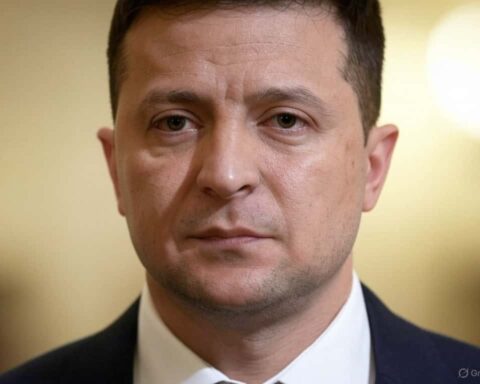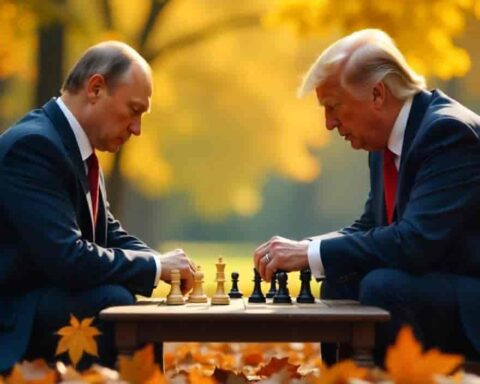The New York Post reported that a direct conversation between former President Trump and Russian President Putin took place regarding ending the conflict in Ukraine. Trump, who expressed a desire to end the war but had not publicly outlined a plan, mentioned the high level of violence in the region.
Despite Trump acknowledging positive discussions with Putin, the exact frequency of their conversations remained undisclosed. Kremlin spokesman Dmitry Peskov acknowledged various forms of communication between the two leaders but refrained from confirming or denying the specifics of the reported phone call.
Background on the Ukraine war
The conflict in eastern Ukraine originated in 2014 following the ousting of a pro-Russian president during the Maidan Revolution and Russia’s subsequent annexation of Crimea. The situation escalated when Putin deployed troops into Ukraine in 2022 under the guise of protecting Russian-speaking individuals and countering perceived threats from NATO’s potential Ukrainian membership.
This move was met with strong opposition from Ukraine and its Western allies, with accusations of imperialism and pledges to resist Russian incursions. As a result, significant portions of Ukrainian territory are now under Moscow’s control, with Russian forces making swift advances since the onset of the 2022 invasion.
Details of the phone call between Trump and Putin
The direct conversation between President Trump and Russian President Putin was focused on ending the war in Ukraine, as reported by the New York Post. Trump, who has expressed his intention to resolve the conflict but has not publicly outlined his strategy, acknowledged that the ongoing situation in Ukraine was taking a toll on the population.
During the interview, Trump refrained from disclosing the exact number of times he had engaged in discussions with Putin, emphasizing the Russian leader’s desire to see an end to the loss of life in the region. The White House chose not to provide additional comments on the matter.
Previous interactions between the two leaders
Kremlin spokesman Dmitry Peskov acknowledged that various channels of communication are utilized for interactions between Trump and Putin. The nature of these communications has not been explicitly confirmed or denied. The conflict in eastern Ukraine dates back to 2014 when pro-Russian sentiments led to unrest following the change in leadership in Ukraine.
Putin’s decision to send troops into Ukraine in 2022 was framed as a military operation to safeguard Russian-speaking communities and counter perceived threats posed by Ukraine’s potential NATO membership. This move was met with opposition from Ukraine and its Western allies, who viewed it as an act of aggression. The territorial control by Moscow in Ukraine has expanded rapidly, resembling the early stages of the 2022 invasion.
Statements from Trump
Trump’s commitment to end the war in Ukraine
President Trump conveyed his commitment to resolving the war in Ukraine during a recent direct phone call with Russian President Putin, as reported by the New York Post. Although Trump has not publicly detailed his strategy for accomplishing this goal, he acknowledged the dire humanitarian impact of the conflict in Ukraine.
The nature of their previous conversations on this issue was not disclosed by Trump, who highlighted Putin’s shared desire to prevent further loss of life in the region. The White House opted not to provide additional information or comments on the matter.
Trump’s perspective on the situation in Ukraine
Kremlin spokesperson Dmitry Peskov acknowledged that various communication channels are utilized for interactions between President Trump and President Putin, without confirming or denying specifics. The conflict in eastern Ukraine traces back to 2014, stemming from pro-Russian sentiments after a change in leadership.
In 2022, Putin’s deployment of troops into Ukraine was framed as a defensive measure to protect Russian-speaking communities and counter perceived threats from Ukraine’s potential NATO integration. The move was met with condemnation from Ukraine and its Western allies, who viewed it as an act of aggression. Moscow’s territorial control in Ukraine has significantly expanded, reminiscent of the initial stages of the 2022 invasion.
Statements from Putin
Putin’s rationale for the military operation in Ukraine
The decision taken by President Putin to launch a military operation in Ukraine in 2022 was justified as a means of protecting Russian-speaking populations within the region. Additionally, the move was aimed at countering what Putin deemed to be a significant threat to Russia’s interests, particularly concerning Ukraine’s potential membership in NATO.
The escalation of the conflict was attributed to the need to safeguard the security and well-being of individuals in eastern Ukraine who identified with the Russian language and culture. Putin’s stance emphasized the idea of preventing any perceived encroachment on Russian influence in the area.
Russia’s goals in the conflict
Russia’s objectives in the ongoing conflict between Ukraine and Russian-backed separatist forces were primarily centered around asserting control over territories that aligned with its strategic interests. The annexation of Crimea by Russia in 2014 marked a crucial shift in the geopolitical landscape, setting the stage for subsequent tensions in the region.
Moscow’s expansionist goals were evident in its military interventions, aiming to secure a significant presence in eastern Ukraine comparable to the state of Virginia in the United States. The swift advancement by Russian forces mirrored the urgency and determination with which Russia sought to assert dominance in the ongoing conflict.
This section elaborates on President Putin’s rationale for the military operations in Ukraine and Russia’s overarching objectives in the protracted conflict, shedding light on the motivations driving Moscow’s actions.
International Response
Reactions from Ukraine and its Western allies
The military operations carried out by Russian forces in Ukraine elicited strong condemnation from Ukraine and its Western allies, particularly led by the United States.
The Ukrainian government, backed by its supporters, viewed the Russian intervention as a blatant violation of sovereignty and territorial integrity, denouncing it as an unjustified act of aggression. Western nations echoed these sentiments, labeling Russia’s actions as destabilizing and imperialistic, vowing to support Ukraine in its defense against Russian forces. The conflict served to deepen existing rifts between Russia and the Western world, exacerbating tensions and prompting heightened security measures in the region.
Impact of the conflict on global relations
The military conflict in Ukraine had far-reaching implications for global relations, sparking widespread concern among the international community. The escalation of violence and the territorial advances made by Russian forces raised alarms about the fragility of security in Europe and the potential for a broader regional conflict. The conflict also strained diplomatic ties between Russia and Western powers, leading to increased sanctions and isolating Russia on the world stage.
The international response to the crisis underscored the significance of upholding international law and deterring aggressive actions that threatened the stability of the global order. The repercussions of the conflict reverberated beyond the borders of Ukraine, shaping the dynamics of international relations and highlighting the need for concerted efforts to address and resolve the ongoing crisis.
Progress of the Conflict in Ukraine
The conflict in eastern Ukraine continues to unfold with ongoing military operations and strategic maneuvers by both Ukrainian armed forces and Russian-backed separatist groups.
The region remains a focal point of intense fighting, with significant humanitarian concerns arising due to the displacement of civilians and the destruction of infrastructure. The situation is marked by heightened tensions and escalating violence, posing a grave threat to the stability and security of the region.
Advances made by Russian forces
Russian forces have made significant advances in eastern Ukraine, rapidly gaining control over territories and pushing further into Ukrainian-held areas. The scale and speed of the Russian military operations have raised international alarm, with concerns over the escalating conflict and its broader implications for regional security.
Moscow’s assertive military campaign reflects its strategic objectives and determination to assert dominance in the ongoing conflict, despite mounting opposition from Ukraine and its Western allies. The rapid progress of Russian forces signals a critical juncture in the conflict, underscoring the challenges faced by Ukrainian forces and the urgency of the situation on the ground.
This section highlights the current dynamics of the conflict in eastern Ukraine, focusing on the advances made by Russian forces and the evolving military situation in the region. The ongoing developments underscore the complex nature of the conflict and the profound impact it has on the local population and broader geopolitical landscape.
Potential Resolutions
Possibilities for ending the war
The conflict in eastern Ukraine presents a complex challenge that demands immediate attention and concerted efforts from all parties involved. As the situation continues to escalate, potential resolutions to the conflict remain a critical focus for the international community.
One possible path towards ending the war could involve diplomatic negotiations aimed at achieving a sustainable ceasefire agreement and facilitating peaceful dialogue between the conflicting parties. Such initiatives would require mutual commitment to de-escalation and conflict resolution, as well as adherence to international legal norms and principles.
Diplomatic efforts to de-escalate the conflict
Diplomatic efforts to de-escalate the conflict in eastern Ukraine are essential in addressing the root causes of the ongoing violence and promoting stability in the region. Diplomatic channels provide an avenue for constructive dialogue and negotiation, offering a strategic framework for resolving disputes and preventing further escalation of hostilities.
By engaging in meaningful diplomatic discussions and consultations, stakeholders can explore options for peaceful conflict resolution and work towards a sustainable peace settlement. Efforts to de-escalate the conflict through diplomatic means are crucial for fostering trust, cooperation, and mutual understanding among the parties involved, ultimately paving the way for a lasting resolution to the conflict.
Future Implications
Consequences of the ongoing conflict
The conflict in eastern Ukraine has led to dire consequences for the region, with escalating violence and military operations resulting in significant humanitarian challenges. The displacement of civilians, destruction of infrastructure, and loss of life have created a humanitarian crisis in the area.
The ongoing conflict has also intensified geopolitical tensions, drawing international attention and condemnation. The rapid advances made by Russian forces and the challenges faced by Ukrainian armed forces underscore the severity of the situation, with implications for regional stability and security.
Prospects for peace negotiations
Despite the intensification of the conflict, there remain some prospects for peace negotiations to address the ongoing crisis in eastern Ukraine. Efforts to seek a diplomatic resolution to the conflict have been met with challenges, but there are continued discussions and initiatives aimed at de-escalating tensions and finding a path towards peace.
The involvement of international stakeholders, including the United States and other Western allies, in facilitating dialogue and negotiations underscores the importance of seeking a peaceful resolution to the conflict. While the road to peace remains uncertain, dialogue and diplomacy offer a potential avenue to mitigate the impact of the conflict and work towards a sustainable solution for the benefit of all parties involved.
This section provides insight into the future implications of the conflict in eastern Ukraine, highlighting the consequences of ongoing military operations and the prospects for peace negotiations. The evolving dynamics of the conflict and the efforts towards finding a peaceful resolution underscore the complexity and challenges faced in addressing the crisis in the region.







